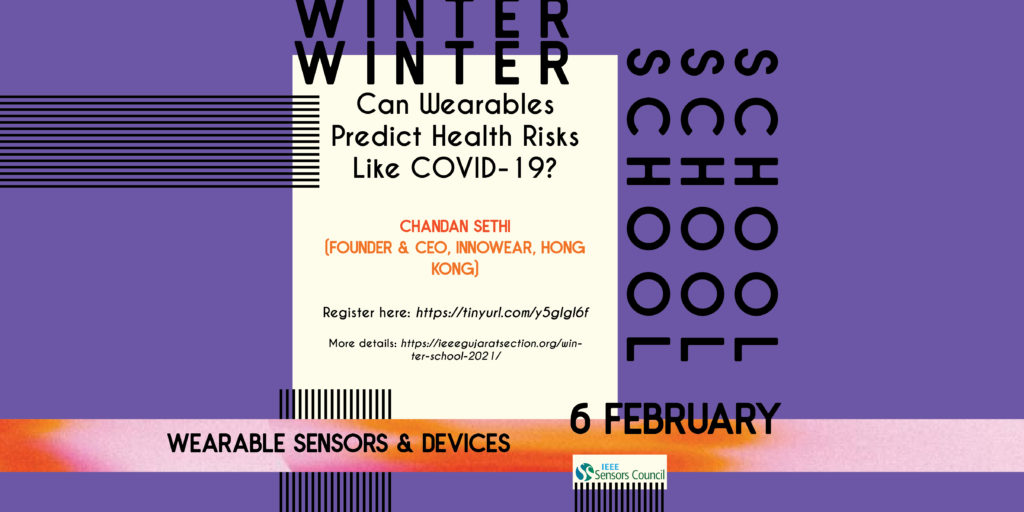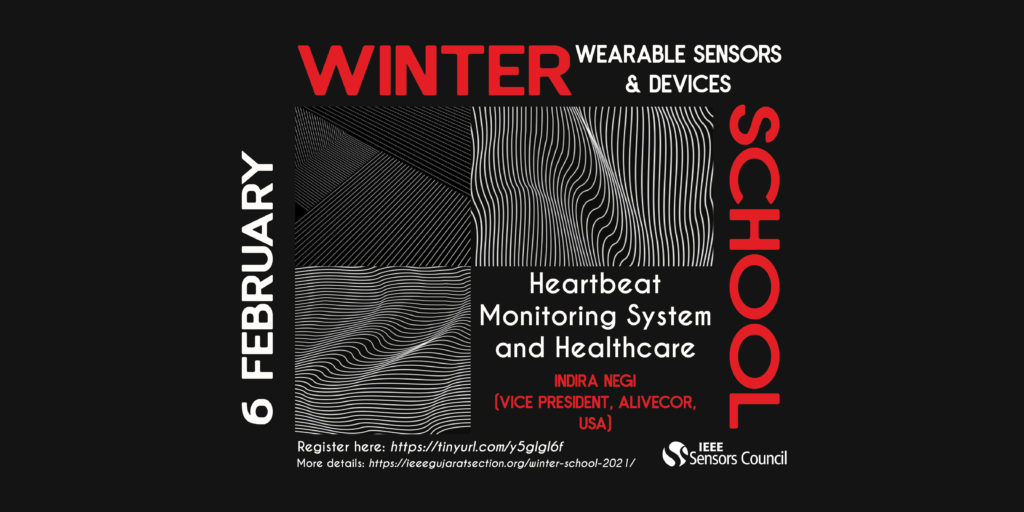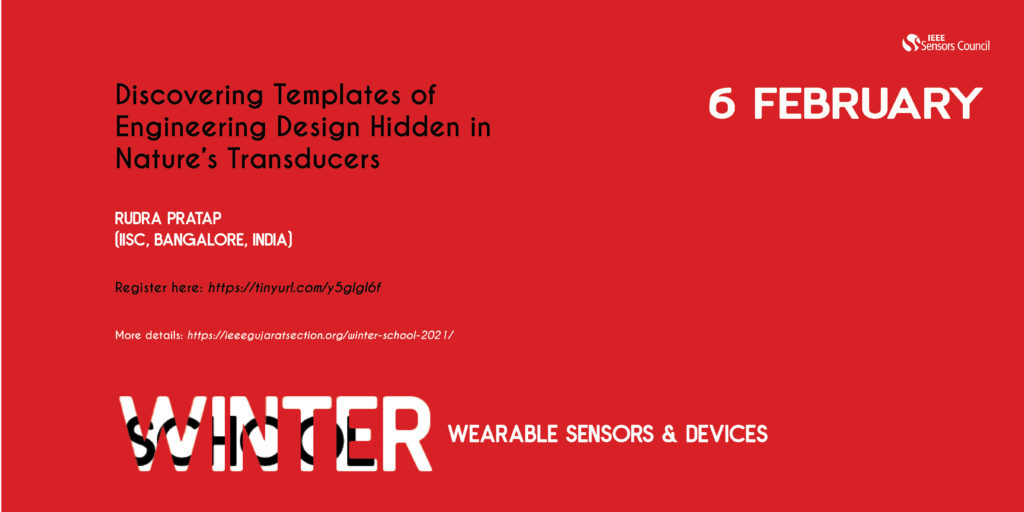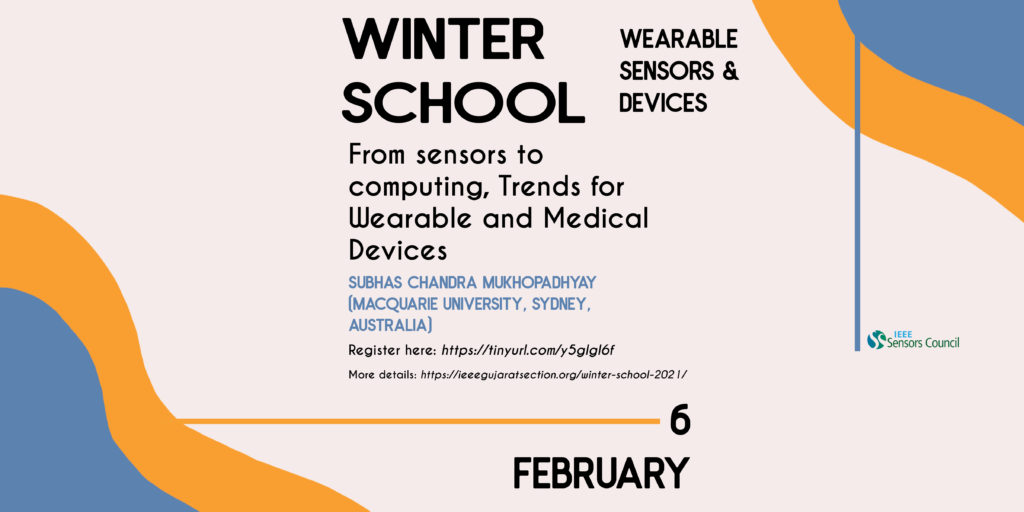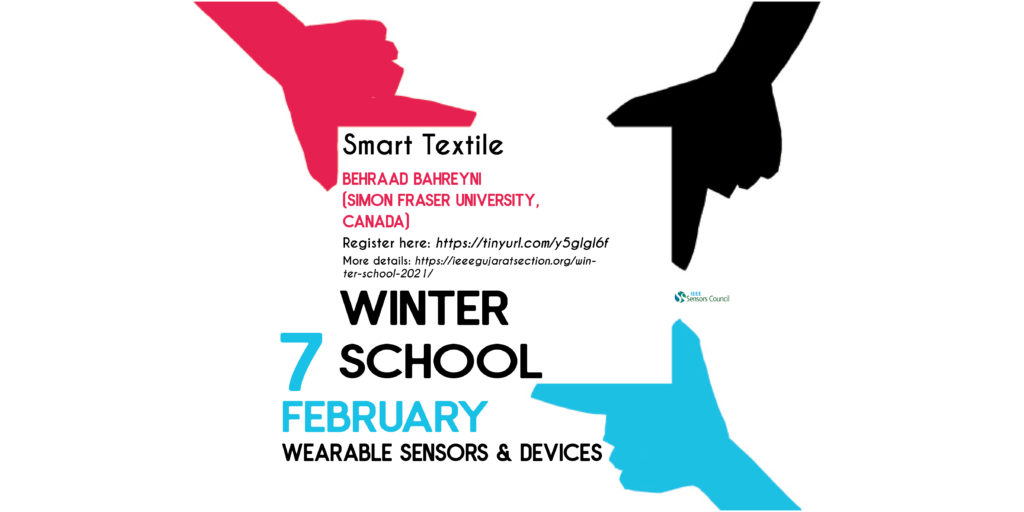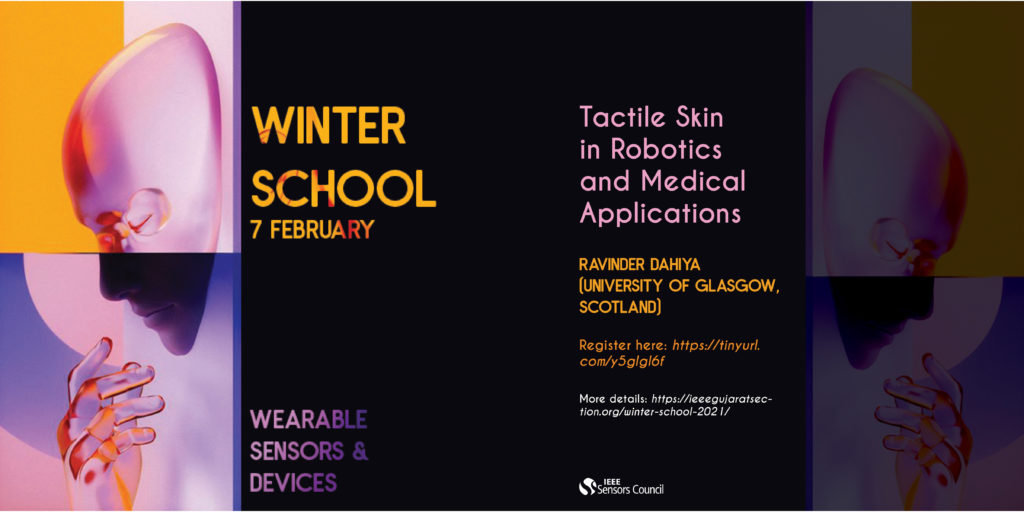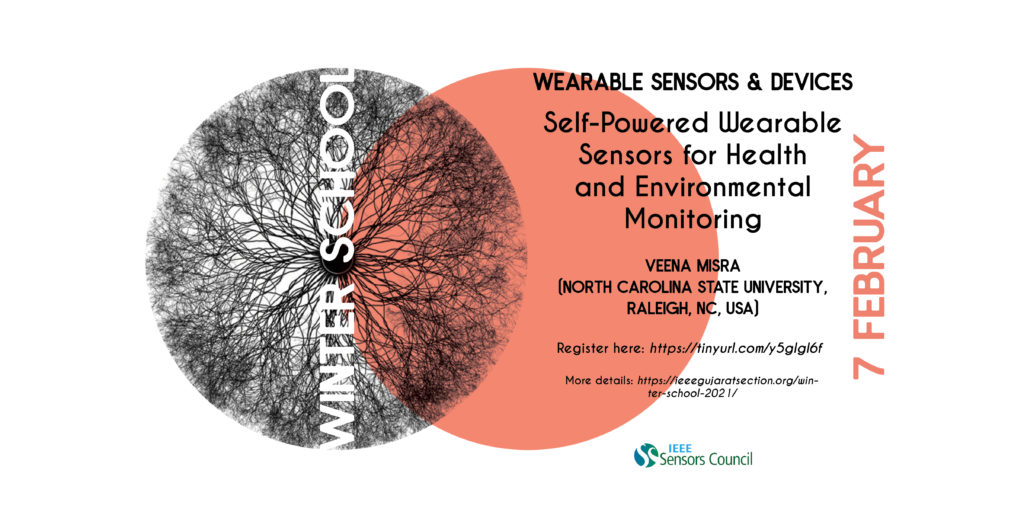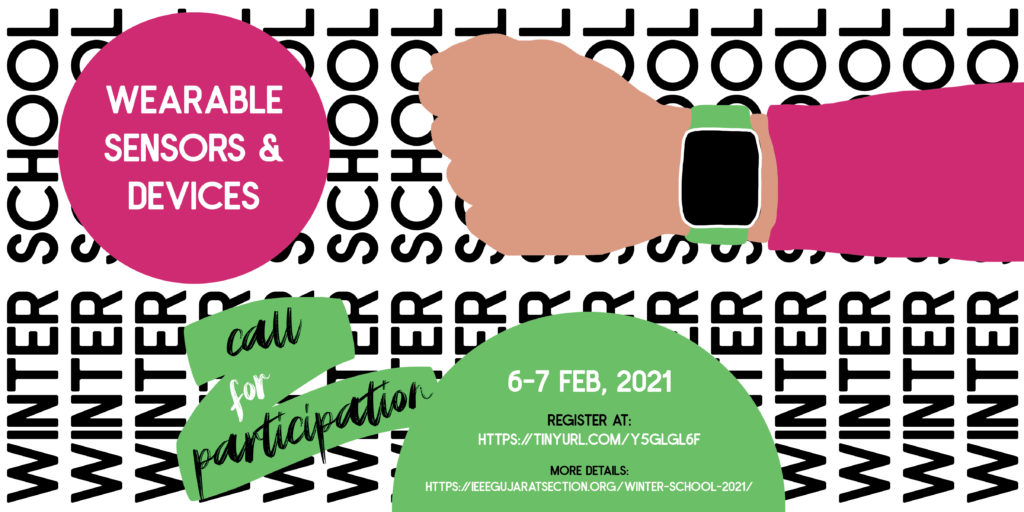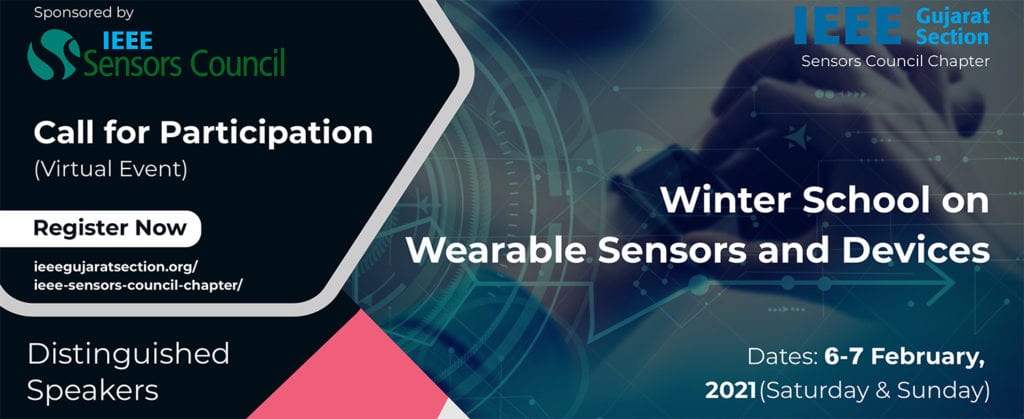
Organizing Committee
- Chonggang Wang & Anil Roy (IEEE Sensors Council)
- Mahmadasraf Mulla (NIT Surat)
- Sanjay Srivastava & Abhishek Jani (DA-IICT,Gandhinagar)
- Anup Shah (InSignEx,Anand)
| 6 February 2021 | |
| Morning Session | |
| 10:00 | Discovering Templates of Engineering Design Hidden in Nature’s Transducers Rudra Pratap (IISc, Bangalore, India) |
| 11:00 | Welcome and Introductory Remarks |
| 11:30 | From sensors to computing, Trends for Wearable and Medical Devices Subhas Chandra Mukhopadhyay (Macquarie University, Sydney, Australia |
| Afternoon Session | |
| 15:00 | Can Wearables Predict Health Risks Like COVID-19? Chandan Sethi (Founder & CEO, innoWear, Hong Kong) |
| 16:00 | A Health Product or a Brilliant Gadget? Indira Negi (Vice President, AliveCor, USA) |
| 7 February 2021 | |
| Morning Session | |
| 10:00 | Smart Textile Behraad Bahreyni (Simon Fraser University, Canada) |
| 11:00 | Wearable Magnetic Skins and Sensors Jürgen Kosel (King Abdullah University of Science and Technology, Saudi Arabia) |
| 12:00 | Key Priorities for Powering Wearables Rahul Todi (International Product Marketing Manager, Dialog Semiconductors, The Netherlands) |
| Afternoon Session | |
| 14:30 | Tactile Skin in Robotics and Medical Applications Ravinder Dahiya (University of Glasgow, Scotland) |
| 15:30 | Self-Powered Wearable Sensors for Health and Environmental Monitoring Veena Misra (North Carolina State University, Raleigh, NC, USA) |
| 16:30 | Quiz on Wearables and Sensors |
| 17:00 | Valedictory Ceremony & Networking |
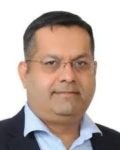
Chandan Sethi
Affiliation: Founder innoWear
Title of the Talk: Can Wearables Predict Health Risks Like COVID-19?
View Abstract
Covid19 as it has wreaked havoc with about 100 Million infected worldwide, and more than 2 million deaths as of Jan 2021. And with no reliable cure available yet, early detection and treatment is important to reduce the loss of lives and cost of healthcare. Having consulted with Doctors and Pulmonologists, we understood this was possible by monitoring specific symptoms of respiratory diseases. We know that most of the patients will have typical patterns, including Fever, Cough, HR and then it impacts lungs so Sp02. We researched and filed provisional patents in India and USA for the solution’ a’ware’
a’ware helps to assess risk of Respiratory diseases. This is done using proprietary algorithms built on vitals data including Sp02, HR, Body Temperature and Cough. The solution includes an App and a wearable device that has multiple sensors to gather data.
Initial algorithms are ready and Prospective Observational Studies are underway in Baroda to gather and validate algorithms for risk prediction. More trials and tests are planned before the product will be released for production.
View Resume
With a career spanning two decades, Chandan has led global cross-functional teams encompassing various fields including Wearable Technology, Consumer Electronics & Healthcare. He was one of the pioneer contributors of Nike Fuelband team which is considered to have started the domain called “Wearables”. He also worked for Amazon Kindle, Nokia & Blackberry mobile phones, IBM Thinkpad, Sony LCD TVs, Ricoh Fax and Photocopier Devices to name a few revolutionary products over the years. He founded innoWear in 2014, with a vison to design & develop wearable products with minimalistic design and highest accuracy. The company already has 5 Wearable products, and developing unique algorithms around Cricket as well as AI enabled wellness ecosystem.
Chandan majored in Mechatronics Engineering, has MBA from the University of Northern Iowa and attended Harvard Business School for Negotiations course.

Indira Negi
Affiliation: VP Product Management – Devices at AliveCor Inc., San Francisco, USA
Title of the talk: A Health Product or a Brilliant Gadget?
View Resume
Indira is a BTech (ICT) from DA-IICT, Gandhinagar, India, 2007; followed by an MS from Arizona State University, 2010. She is an award-winning primary inventor of Intel’s first wearable smart device, Lionheart, a set of earbuds that measure heart rate while simultaneously playing music. She also led the team that designed optical heart rate sensors for the New Balance RunIQ smart watch. She is a co-inventor on nine filed patent applications in consumer electronics.
Indira is currently VP Product Management – Devices at AliveCor Inc., San Francisco, USA. Prior to that she was Global Director of Strategy and Product, Health and Life Sciences at Intel, where along with her team she was responsible for Intel’s Health Strategy and Product Planning. In this capacity she led the Strategic Marketing for Intel’s Heath Business COVID-19.

Rudra Pratap
Affiliation: Founding Chairperson of CeNSE
Title of the Talk: Discovering Templates of Engineering Design Hidden in Nature’s Transducers
View Abstract
Nature uses a plethora of micro and nano-scale sensors in its creations. While many of such sensors and actuators have been identified and studied for their functions in animals and insects, we are only beginning to discover the underlying design templates that Nature uses and creates multiple variants of the design with parameter tweaking. Understanding such design templates is essential as they often contain natural scaling of underlying transduction principles and their implementation with physical designs. The modern tools of imaging and characterization are making the discovery of these design templates possible as we are now able to construct the whole system from the information on its pieces from biological studies and piece-together simulations that tell us the whole story. We have been studying the bioacoustics of crickets in order to understand transducer design for efficient sound amplification as well as directional sound detection. We have been also studying insect halteres as gyroscopes to see how such a simple design lends itself to 3-axis rate of rotation sensing. This talk contains some details of these studies that are targeted at discovering the underlying engineering design and a more generic design template.
View Resume
Rudra Pratap (Ph.D., Cornell University, 1993, M.S., University of Arizona, 1987, B.Tech., IIT Kharagpur, 1985) is a professor at the Centre for Nano Science and Engineering (CeNSE), and Deputy Director of IISc Bangalore. He is also an associate faculty of Mechanical Engineering, IISc, where he served full time until 2010 when he moved to CeNSE as the Founding Chairperson. He joined IISc in 1996 after teaching at the Sibley School of Mechanical and Aerospace Engineering, Cornell University, for almost three years. For the last 20 years, he has worked in the area of Micro-electro-mechanical systems (MEMS) and dynamics of micro and nano-scale systems. His research interests include MEMS and NEMS, vibroacoustics, bioacoustics, mechano-biology, and computational mechanics. He has published approximately 200 papers in journals and conference proceedings. He is author or co-author of three books. He is an Associate Editor of IEEE/ASME Journal of MEMS and Journal of ISSS. He is an elected Fellow of the National Academy of Engineering and National Academy of Science, India. Rudra Pratap is a Distinguished Lecturer of IEEE Sensors Council. He was Technical Program Committee co-Chair for IEEE SENSORS 2018 (New Delhi) and 2019 (Montreal).
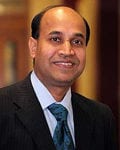
Subhas Chandra Mukhopadhyay
Affiliation: Professor of Mechanical/Electronics Engineering, Macquarie University, Australia
Title of the Talk: Trends for Wearable and Medical Devices
View Abstract
An increase in world population along with a significant aging portion is forcing rapid rises in healthcare costs. The healthcare system is going through a transformation in which continuous monitoring of inhabitants is possible even without hospitalization. The advancement of sensing technologies, embedded systems, wireless communication technologies, nano-technologies, and miniaturization makes it possible to develop smart medical systems to monitor activities of human beings continuously. Wearable sensors monitor physiological parameters continuously along with detect other symptoms such as any abnormal and/or unforeseen situations which need immediate attention. Therefore, necessary help can be provided in times of dire need. This seminar reviews the latest reported systems and the trends on wearable and medical devices to monitor activities of humans and issues to be addressed to tackle the challenges.
View Resume
An IEEE Fellow, Subhas holds a B.E.E. (gold medal), M.E.E., Ph.D. (India) and Doctor of Engineering (Japan). He has over 30 years of teaching, industrial and research experience. Currently he is working as a Professor of Mechanical/Electronics Engineering, Macquarie University, Australia and is the Discipline Leader of the Mechatronics Engineering Degree Programme. Before joining Macquarie he worked as Professor of Sensing Technology, Massey University, New Zealand. His fields of interest include Smart Sensors and sensing technology, instrumentation techniques, wireless sensors and network (WSN), Internet of Things (IoT), numerical field calculation, electromagnetics.
He has published over 400 papers in different international journals and conference proceedings, written seven books and forty two book chapters and edited seventeen conference proceedings. He has also edited thirty two books with Springer-Verlag and twenty four journal special issues.
Subhas is a Fellow of IET (UK), a Fellow of IETE (India). He is a Topical Editor of IEEE Sensors journal. He is also an Associate Editor of IEEE Transactions on Instrumentation and Measurements and IEEE Transactions on Review of Biomedical Engineering. He is a Distinguished Lecturer of the IEEE Sensors Council from 2017 to 2022. He is the Founding chair of the IEEE Sensors Council NSW chapter.
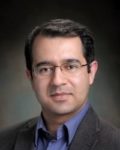
Behraad Bahreyni
Affiliation: Associate Professor and the founding Director of the Intelligent Sensing Laboratory at Simon Fraser University, BC, Canada
Title of the Talk: Smart Textile
View Abstract
Smart Textiles are gathering increasing interest as form of wearable systems with numerous potential applications. Compared to e-Textile, Smart Textile are able to sense various phenomena in the environment and react or adapt to them. Providing such capabilities requires the development of methods to incorporate suitable fibers into the structure of a textile or build such functionality into the textile as part of the manufacturing process. Depending on the application, the stimulus may be in the form of an electrical, thermal, chemical, or optical signal among others, creating an exciting research and development space.
This talk provides a high-level overview of the applications of Smart Textile, with examples from activity monitoring, biomedical sensing, and fashion. We will discuss some of the common signal transduction approaches, which can then be employed to develop textile systems for such applications. Challenges on developing textile systems will be overviewed with examples on current approaches and solutions. We finally introduce possible manufacturing methods for smart textile, including a recent development in our group to create sensitive fibers for different applications.
View Resume
Dr Behraad Bahreyni is an Associate Professor and the founding Director of the Intelligent Sensing Laboratory at Simon Fraser University, BC, Canada since 2008. He received his BSc in electronics engineering from Sharif University of Technology, Iran, and MSc and PhD degrees in Electrical Engineering from the University of Manitoba, Canada, in 1999, 2001, and 2006, respectively. In 2016, he was with NXP Semiconductors, the Netherlands, researching on advanced signal processing methods for sensing applications. Over the past decade, his research activities have focused on the design and fabrication of micro/nano-sensors, their interface electronics, and the required signal processing algorithms as well as the applications of sensor systems in wearables and Internet-of-Things. Dr Bahreyni has contributed to more than 150 technical publications including seven patents and a book on the fabrication and design of resonant microdevices.
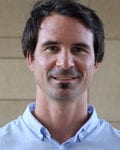
Jürgen Kosel
Affiliation: Head of the research unit Sensor Applications at the Division of Sensor Systems at Silicon Austria Labs
Title of the Talk: Wearable Magnetic Skins and Sensors
View Abstract
Magnetic sensors are one of the most pervasive sensors in industry and consumer devices. They have a very long history starting with the compass more than 2000 years ago. Many different magnetic sensors have been developed, exploiting various physical principles, to obtain optimized performance for specific applications with respect to sensitivity, power consumption, size, field range or resolution. In the era of ubiquitous sensing, wearable devices and smart things, the unique features of magnetic sensing systems put them at the forefront of novel applications and new features.
This presentation provides insights into latest developments on flexible magnetic skins and sensors, which feature high performance, biocompatibility and conformability. Such devices are employed in biomedical instruments, marine monitoring, or machine-user interfaces, enhancing functionalities and capabilities. Flexible and wearable magnetic sensor systems can extend our senses, provide contactless control or steering and add intriguing new functionalities to our natural capabilities. Examples are flexible magnetic tunnel junction sensors, which are employed for 3-axes orientation monitoring on biomedical instruments. On the other end of the spectrum are printed graphene Hall effect sensors with less sensitivity but high temperature and corrosion resistance. Magnetic composites made of polymers with magnetic materials as fillers combine mechanical flexibility with magnetic functionality. Such materials have been integrated with magnetic sensors to form bioinspired artificial cilia sensors, resulting in low-power tactile sensors with multifunctional capabilities as artificial skins, for flow sensing or brail reading. Ultra-flexible magnetic skins can be worn like tattoos or camouflaged with the color of the skin tone and enable wireless operations, ranging from tracking of eye movements to hands-off machine control.
Modern fabrication processes combined with the advantages of magnetic sensor systems are a strong combination, which can lead to a myriad of new sensor solutions and benefit smart things, robotics, medical devices and much more.
View Resume
Jürgen Kosel is head of the research unit Sensor Applications at the Division of Sensor Systems at Silicon Austria Labs since 2020. He is also Adjunct Professor of Electrical Engineering at the Division of Computer Electrical and Mathematical Sciences and Engineering at the King Abdullah University of Science and Technology (KAUST). He was Assistant Professor and Associate Professor of Electrical Engineering at KAUST since 2009 and 2015, respectively, where he was Principle Investigator of the Sensing Magnetism and Microsystems Research Group and Head of the Advanced Micro and Nanosystems Lab. He has been CSO of Solutions for Nanotechnology in 2015 and 2016.
Jürgen is IEEE Sensors Council Distinguished Lecturer for the years 2020-2022. He has authored over 150 journal articles, over 130 conference proceedings and 10 book chapters. He filed 40 patents or patent applications. He has been an Associate Editor of the IEEE Sensors Journal since 2015. A Senior Member of the IEEE, Jürgen is the AdCom member of the IEEE Sensors Council and the IEEE Magnetics Society too.
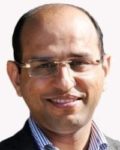
Ravinder Dahiya
Affiliation: Professor of Electronics and Nanoengineering and EPSRC Research Fellow
Title of the Talk: Tactile Skin in Robotics and Medical Applications
View Abstract
The miniaturization led advances in microelectronics over 50 years have revolutionized our lives through fast computing and communication. Recent advances in the field are propelled by applications such as robotics, wearable systems, surgical instruments and health monitoring etc., which require electronics to conform to 3D surfaces. This calls for new methods to realize sensing, electronics, and energy related components on unconventional substrates such as plastics and paper. This lecture will present various approaches (over different time and dimension scales) for obtaining distributed electronics and sensing components on flexible and conformable substrates, especially in context with tactile or electronic skin (e-skin). These approaches range from distributed off-the-shelf electronics, integrated on flexible printed circuit boards to advanced alternatives such as e-skin by printed nanowires, graphene and ultra-thin chips, etc. The lecture will also discuss the how large area tactile sensing has changed the research paradigm in robotics from hand-based manipulation to using large body contacts to plan and execute movements even in unstructured environments. The technology developed for sensitive flexible (and possibly stretchable) touch sensing based systems could also enable solutions for numerous emerging fields such as internet of things, smart cities and mobile health as well as global issues related to sustainable environment and health and safety. This lecture will also discuss how the flexible electronics research may unfold in the future.
View Resume
Ravinder Dahiya is Professor of Electronics and Nanoengineering and EPSRC Research Fellow. He is the leader of Bendable Electronics and Sensing Technologies (BEST) research group and currently he is also the director of Electronics Systems Design Centre (ESDC). His multidisciplinary group conducts fundamental research on high-mobility materials based flexible electronics, electronic skin, and wearable systems and their application in robotics, prosthetics and healthcare. He has published about 350 research papers in reputed journals and peer reviewed international conferences, 15 submitted/granted patents, 7 books, and several book chapters.
Professor Dahiya is Fellow of IEEE and IES. He is the President-Elect (2020-21) and a Distinguished Lecturer of IEEE Sensors Council. He serves on the Editorial Boards of Scientific Reports (Nature Group) and has also served on the editorial boards of IEEE Sensors Journal and IEEE Transactions on Robotics. He is editor of ‘Flexible and Large-Area Electronics‘ elements series by Cambridge University Press. He has been guest editor for 10 Special Journal Issues, including for the Proceedings of the IEEE.

Rahul Todi
Affiliation: International Product Marketing Manager at Dialog Semiconductors.
Title of the Talk: Key Priorities for Powering Wearables
View Abstract
Over the last few years, we’ve seen the popularity of wearables surge across various market segments. It’s easy to see why: these products are packed with some of the latest and complex technological advancements and aim to improve well-being and simplify day to day tasks and activities in a completely intuitive and unobtrusive manner. A wearable product design should include all of the necessary hardware components to realize their required functionality and meet their users’ needs. Hence, power management for wearables becomes a very critical aspect to achieve robust performance coupled with a longer battery lifetime, all at a competitive cost. This talk will outline how designers and manufacturers can integrate new system components into different types of wearables to drive new value for customers, especially on the power management side.
View Resume
Rahul Todi did his BTech in ICT from DA-IICT, Gandhinagar, India followed by M.Sc. degree in Microelectronics from the Technical University of Delft, Delft, The Netherlands. He has over 10 years of experience in the Wireless Connectivity space, with focus on low power systems. Over the years, he has been associated with Dialog, NXP, Qualcomm and Intel on various projects. He has publications in the prestigious International Solids State Circuits Conference and is the inventor/co-inventor of 5 patents in the field of low power wireless designs.
He is currently working as an International Product Marketing Manager for Bluetooth Low Energy Business unit of Dialog semiconductors. He is leading Korea and India region and is responsible for next generation product roadmap and strategy. He has been involved in multiple SoCs right from concept to launch which are currently powering industry leading consumer flagship products.

Veena Misra
Affiliation: Director of the National Science Foundation Nanosystems Engineering Research Center, Advanced Self-Powered of Integrated Sensors and Technologies (ASSIST)
Title of the Talk: Self-Powered Wearable Sensors for Health and Environmental Monitoring
View Abstract
Health care spending continues to rise globally and the costs in U.S. now exceed any other industrialized country. Since chronic diseases makeup majority of the health care costs, a disruptive solution to address the health care challenge is to empower users and providers with technologies that provide personal health status and inform patients and doctors with better choices while also enabling rapid and effective treatment. The hassle-free and battery-free features of wearable sensors devices can not only increase adoption and compliance but also enable long-term and continuous monitoring of many key health and environmental parameters. As an example, continuous monitoring of data can provide doctors with trends in physiological data leading up to a traumatic event, making treatment and medication regimes significantly more rapid and effective, and providing feedback to doctors on efficacy of prescribed medications and long-term physical response. Recent advances in nanomaterials, nanostructures, and nanodevices have increased efficiency of energy harvesters, lowered energy per computational bit, increased capacitor storage density, and enhanced nanosensor efficiency making autonomous operation realizable. In this talk, I will how these advances are being combined together to build self-powered wearable sensor systems, which can enable long-term sensing and effective management of chronic conditions, sensing of personal exposure to air pollutants and toxins and provide longitudinal studies that can provide new insight into correlation of various health and environmental parameters. Such sensor systems can empower patients and providers to manage wellness instead of managing illness, assist in effective treatment of at-risk elderly, reinforce healthy lifestyles, and provide new tools for long-term environmental exposure health studies. In order to achieve self-powered operation, it is essential to maximize the power generated from the body and minimize the power consumed by sensors, computation, communication and power management to achieve the self-powered operation. Recent advances in nanomaterials, nanostructures, and nanodevices have increased efficiency of energy harvesters, lowered energy per computational bit, increased capacitor storage density, and enhanced nanosensor efficiency making a self-powered system finally realizable. To address these needs effectively, the ASSIST Center has focused on engineered systems-level approach where the system levels needs drive all the research. I will discuss the challenges in technology development, including energy harvesting, ultra low power radios and durability, needed to realize these sensor systems and explore the role that data will play in making these systems effective for both the patient and the provider.
View Resume
Veena Misra received the B.S., M.S., and Ph.D. degrees in electrical engineering from North Carolina State University, Raleigh. She is the Director of the National Science Foundation Nanosystems Engineering Research Center, Advanced Self-Powered of Integrated Sensors and Technologies (ASSIST). She is a Distinguished Professor of Electrical and Computer Engineering with North Carolina State University. After working at the Advanced Products Research and Development Laboratories, Motorola Inc., Austin, TX, USA, she joined the faculty of North Carolina State University in 1998. She has authored or coauthored over 150 papers in the areas of state-of-the-art low-power CMOS devices, power devices, alternative high-mobility substrates, nanoscale magnetics, and energy-harvesting. Dr. Misra was a recipient of the 2001 National Science Foundation Presidential Early CAREER Award, the 2011 Alcoa Distinguished Engineering Research Award, the 2007 Outstanding Alumni Research Award, and the 2016 R. J. Reynolds Award. She also served as the General Chair of the 2012 IEEE International Electron Device Meeting.
Registration Form Link: Click here to Register (hyperlink: https://tinyurl.com/y5glgl6f)
Masters & Ph.D. students, faculty, and practitioners (including industry professionals) working in the sensors domain are highly encouraged to register and attend this event.
Only registered participants will be allowed to attend it.
We have also observed that due to the online delivery of such events there is a huge difference between the people who register and the people who actually attend. This difference discourages the speakers to deliver audience-specific talks. Therefore, we have kept a nominal registration fee to keep the non-serious persons from registering. Hope you appreciate it.
Registration Fee:
For Indian Delegates: INR 400 + GST
For the Delegates outside India: USD 25 (including tax and convenience charge)
Registration will close at midnight 5 February 2021.
For registration follow the link: https://tinyurl.com/y5glgl6f
All registered delegates will receive a digital version of participation certificate after actual participation in the event.
For Registration related query, pl contact:
Mr. Gautam Menon
Phone: +91 9731 26 1053
Email: gautam@cimglobal.net



